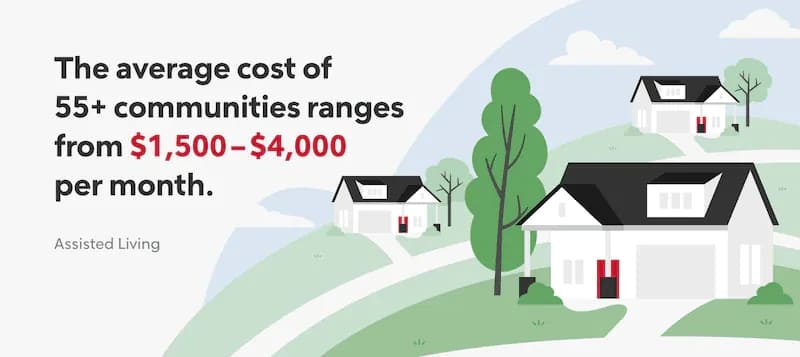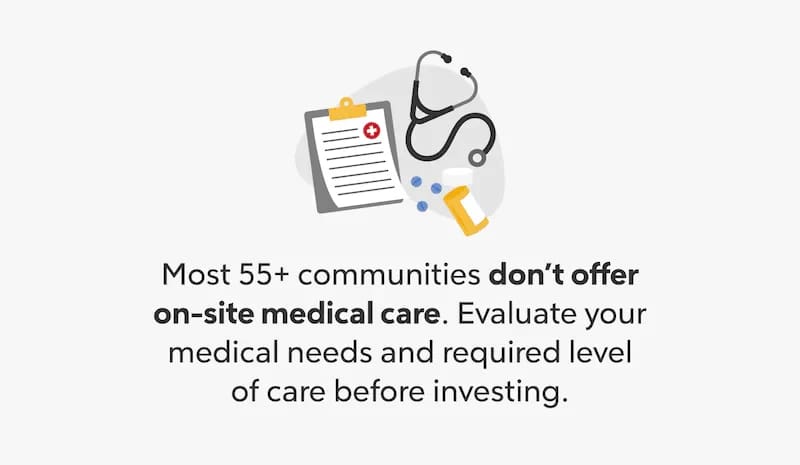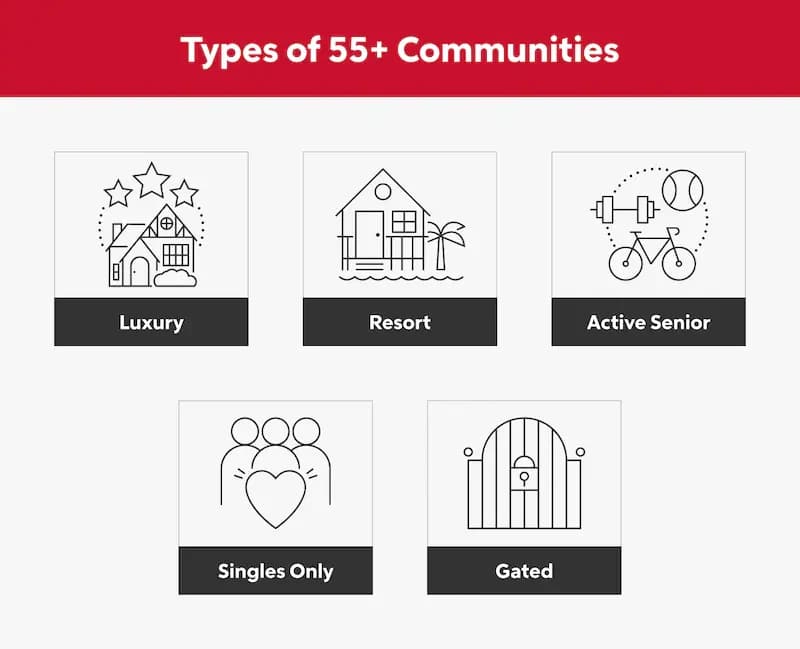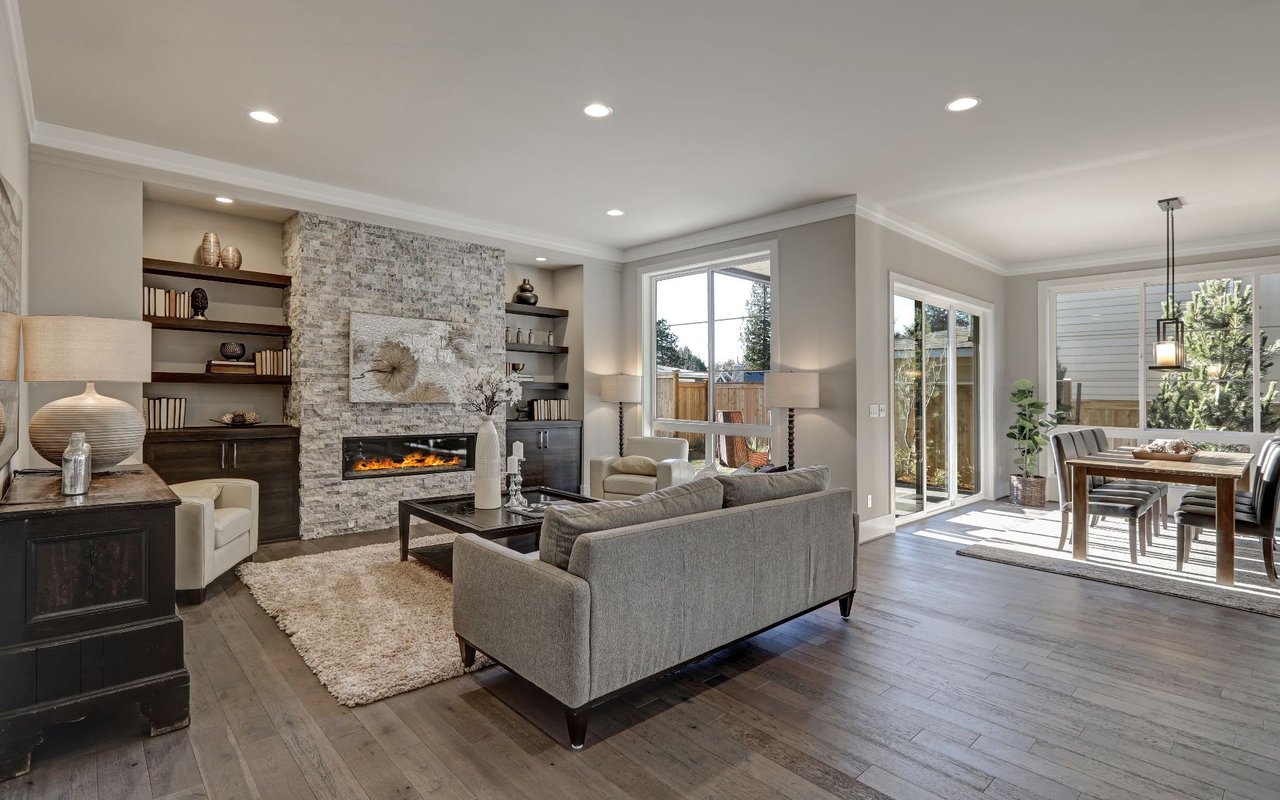A 55+ community is an established active adult living area that has at least one resident living on each property over the age of 55. These retirement communities are designed with a target market over the age of 55 in mind, from amenities to location.
Types of homes in 55+ communities are typically smaller, and you’ll often see them in areas with apartments, condos, and townhouses. These smaller-sized units are a great way to downsize your life and start a new chapter.
With 55+ communities, they’re able to offer residents a sense of belonging and community. You’re able to connect with neighbors of similar ages and continue to enjoy your retirement years in a safe and peaceful environment. If you’re planning to purchase a new home or property after retirement age, let’s dive deeper into the pros and cons of 55+ communities and if they’re worth the investment.
Table Of Contents:
- What Is A 55+ Community?
- Pros And Cons Of 55+ Communities
- Types Of 55+ Communities
- Are 55+ Communities Worth It?
- Can Someone Under 55 Buy In A 55+ Community?
Pro #1. Cheaper Cost Of Living
Buying a retirement home in a 55+ community may be a cheaper option if you still want to live independently but with the benefit of added amenities. The average cost of a 55+ community is $1,500 – $4,000 per month. Comparatively, the average monthly mortgage payment in the United States is $1,595, while the average monthly rental payment is $1,062.
The monthly cost of an active living community will depend on the state you reside in. Certain communities will require a one-time move-in fee as well. For more information on the actual cost of living, connect with the community’s sales counselor.
Before committing to the move, look into refinance programs for seniors to understand all of your possible housing options and get the best rate.

Pro #2. Community Location
You can find a 55+ community almost anywhere in the United States. However, the ideal location for these communities is in areas that see the sun all year round, which is mostly in the Sun Belt states, like Arizona and Florida. In fact, Florida has the highest number of active adult communities at 969 locations. Plus, you’ll find that most of these communities are strategically placed near quality medical facilities.
Pro #3. Safety And Security
These active retirement communities are typically gated and in areas with low crime rates. Guests of residents usually will need to be approved by those living in the communities. Some 55+ communities also have on-site security teams for added safety.
Pro #4. Low Property Taxes
Property taxes tend to be lower in active adult communities, as these communities aren’t in dire need of supporting school funding and after-school programs like other residential neighborhoods are.
Pro #5. Amenities And Low-Maintenance
Perhaps the best perk of living in 55+ communities is that they provide amenities galore. Plus, home and community maintenance is usually taken care of, including home and landscape maintenance. Your HOA dues and fees will go toward covering maintenance costs.
Amenities that may be provided include:
- Sports courts
- Fitness centers
- Golf courses
- Dining areas
- Classes
- Social events
- Dog parks
- Art rooms
Pro #6. Offers Peaceful Serenity
Goodbye noise complaints, hello peace and quiet! These communities are typically quieter compared to residential neighborhoods with families that have younger children. However, you may see a grandchild come and visit their grandparents every once in a while.
Pros And Cons of 55+ Communities To Consider
| Pros | Cons |
| Pros Cons Little to no home maintenance and landscaping required | Limited landscaping options |
| Connect with others in your age range | Less interaction with a variety of age groups |
| Less upkeep with a downsized space | Downsizing means getting rid of items |
| Homeowners association provides services to keep the community beautiful | Homeowners associations require fees and payments |
| Participate in similar interests with neighbors | Limited groups of residents to connect with |
| May provide transportation to medical services and shopping | Trips may be limited to certain days of the week |
| Designed with homeowners that are 55+ in mind | Living spaces may need updating |
Con #1. HOAs
Most 55+ communities have some form of a homeowners association (HOA). Homeowners associations collect dues and fees from community members that are then used to pay for large community expenses, like renovating a shared community space.
However, problems can easily arise with HOAs, stemming from extensive regulations to unexpected added dues. Before purchasing a property in a 55+ community, take time to learn more about the health of the HOA in the retirement community you’re considering.
Here are questions you should ask the community advisor:
- Who is on the HOA board of directors?
- What do the monthly fees and dues look like?
- How much funding is in the reserve?
- What is the best form of communication with the HOA board of directors?
- Are there community meetings we may attend to discuss the HOA agenda?
Con #2. Lack Of Age Diversity
Usually, at least one person in each residence has to be 55 or older in a 55+ community. However, most people that live in these communities are above that age minimum. If you’re looking to be amongst varied age groups over one consistent age bracket, you may want to consider if you would enjoy living in a 55+ community versus living in a neighborhood.
Con #3. No Medical Care On-Site
In a 55+ community, health care services or assisted living care aren’t typically offered as part of the monthly HOA fee. The reason is that these active adult communities are created with a focus on independent living, rather than care services.
You can arrange for home care assistance through a third party if you require additional services. Some 55+ communities do have contract arrangements with third-party home care professional services that you may use. However, if you require extensive medical care and daily assistance, you may want to look into another community like assisted living residencies.

Con #4. Rules And Regulations
While the HOA does collect fees from community members, it also enforces regulations and community bylaws that residents must abide by. If a resident violates a rule, the HOA may impose a fine. These regulations can be quite extensive, so it’s best practice to read the rules thoroughly before joining a retirement community.
Examples of HOA regulations include:
- How you may customize your home
- Any landscaping outside your home, including new plants
- How you may decorate the exterior of your home
- Age requirements to live in the community
- How you can and can’t use the offered amenities
Con # 5. Smaller Homes
There are typically smaller units in 55 communities, like an apartment or condo, and designed for two people to live in. You may be downsizing from a large home to a smaller space, so plan to organize belongings for storage or sort through it all with your family before moving.
Types of 55+ Communities
There are several different types of 55+ communities to choose from. Your choice will depend on what you’re looking to get from joining one community over another.
- Luxury communities: You will find larger homes with more amenities and luxury-level features available to residents in this type of community.
- Golf and resort communities: Just like the name suggests, these communities offer a resort-like environment with quality amenities. What’s more of a vacation than living on a beautiful golf course?
- Active senior communities: These 55+ communities are for those who live a more active lifestyle. They offer plenty of recreational activities, such as golfing, swimming, and biking.
- Singles-only communities: These communities are designed for unmarried individuals. The communities will typically offer events and opportunities for residents to meet and connect.
- Gated communities: This type of community has all the premiums of a 55+ community with added security and heightened privacy.

Are 55+ Communities Worth It?
Now, you might be asking yourself, “Is an active adult community right for me?”
If you’re looking to enjoy your retirement in a safe and peaceful community with others who are in the same stage of life, a 55+ community may be the right match for you. These communities can offer a gradual transition into a new chapter of your life, which you can still enjoy to the fullest by actively using provided amenities and getting to know your neighbors.
However, if you aren’t quite ready for a quieter lifestyle and would prefer to interact with a mix of age groups on a more regular basis, you might think about waiting a couple more years before moving into one of these communities.
Just because you may be 55 or older doesn’t necessarily mean you need to join a 55+ community. The way you want to live your retirement is solely based on your needs and preferences.
Can Someone Under 55 Buy In A 55+ Community?
Yes, someone under 55 may buy in a 55+ community. However, at least one of the residents living in the home must be over the age of 55. It can also depend on the community’s own guidelines and regulations with the age requirement. If you’re under the age of 55 and want to buy in one of these communities, research the rules and regulations of the specific community beforehand.
If you’re debating whether it’s the right time to purchase a home in a 55+ community, take your time to first understand the benefits and drawbacks of making that move.




